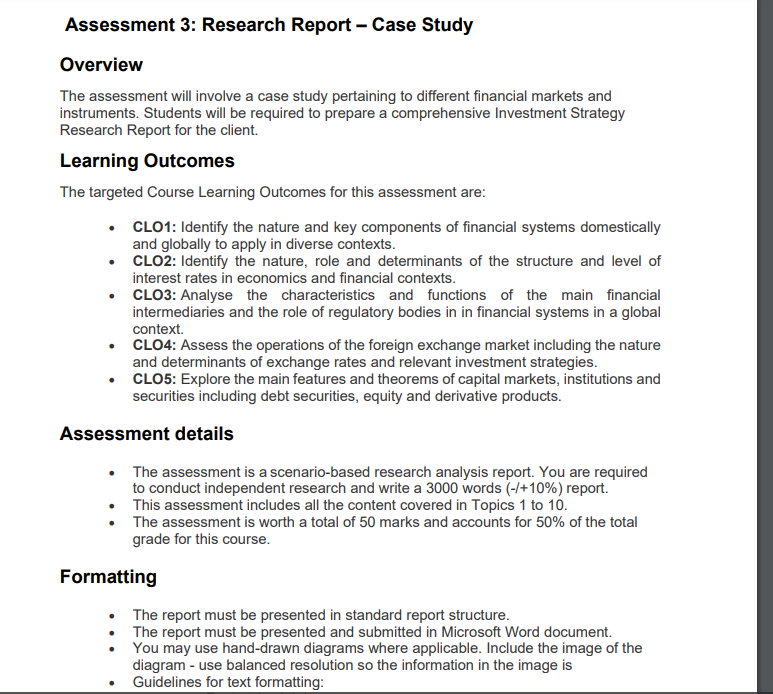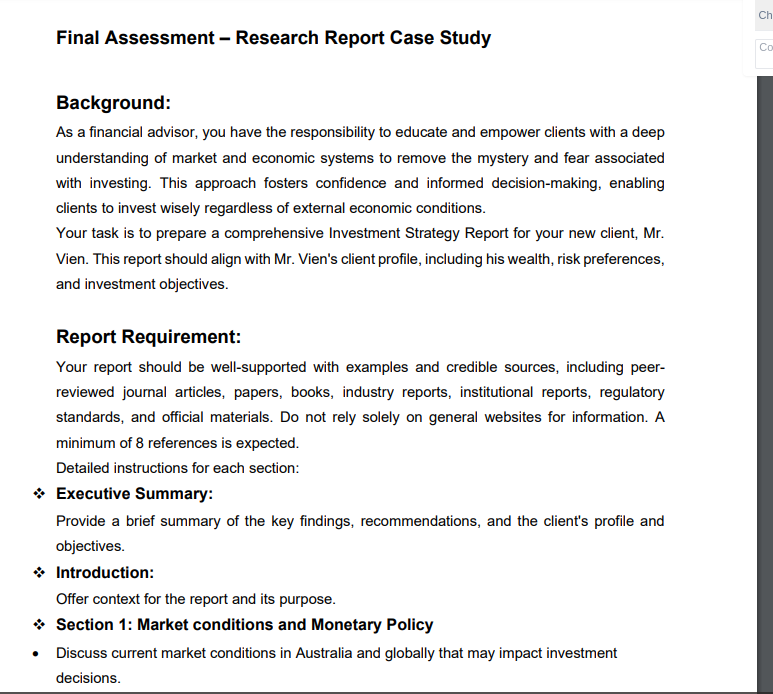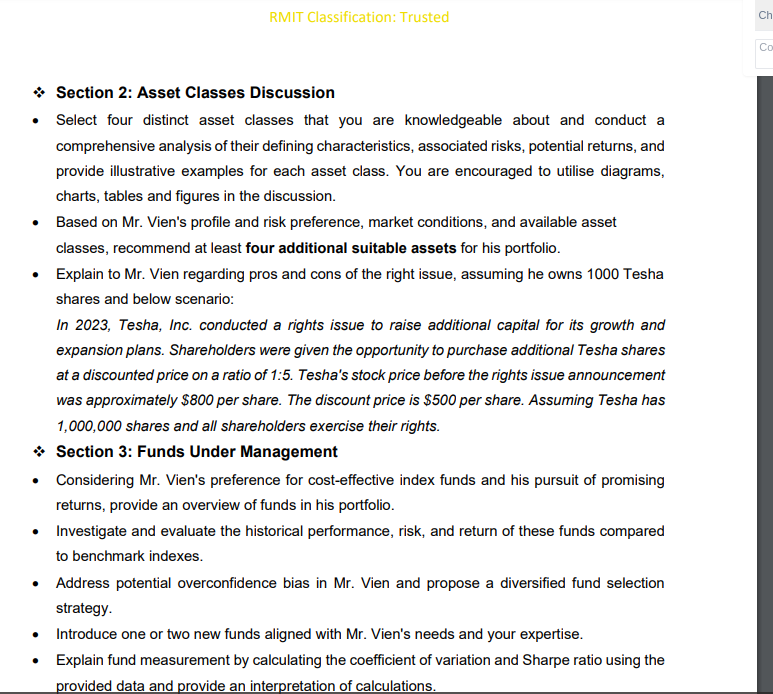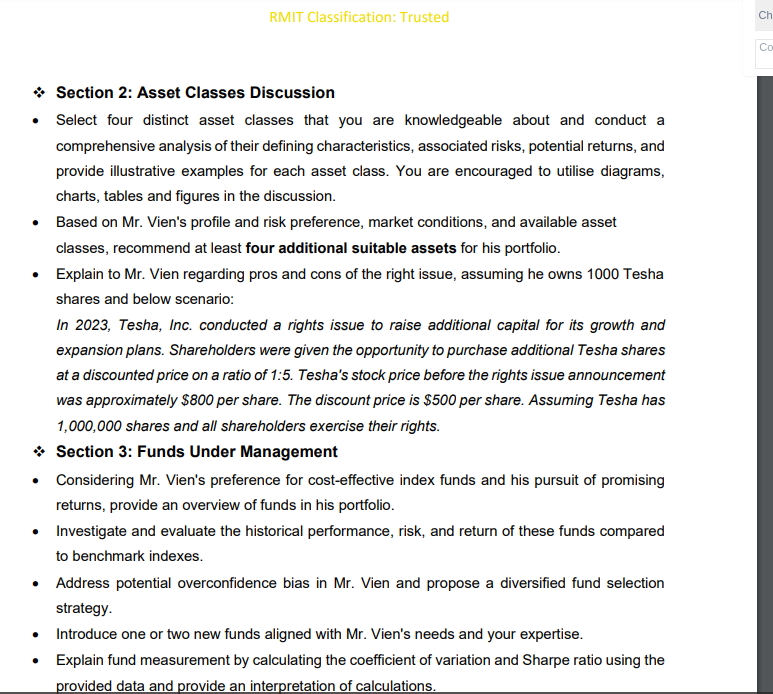Assessment 3: Research Report - Case Study
Overview
The assessment will involve a case study pertaining to different financial markets and
instruments. Students will be required to prepare a comprehensive Investment Strategy
Research Report for the client.
Learning Outcomes
The targeted Course Learning Outcomes for this assessment are:
• CLO1: Identify the nature and key components of financial systems domestically
and globally to apply in diverse contexts.
CLO2: Identify the nature, role and determinants of the structure and level of
interest rates in economics and financial contexts.
CLO3: Analyse the characteristics and functions of the main financial
intermediaries and the role of regulatory bodies in in financial systems in a global
context.
• CLO4: Assess the operations of the foreign exchange market including the nature
and determinants of exchange rates and relevant investment strategies.
CLO5: Explore the main features and theorems of capital markets, institutions and
securities including debt securities, equity and derivative products.
Assessment details
The assessment is a scenario-based research analysis report. You are required
to conduct independent research and write a 3000 words (-/+10%) report.
This assessment includes all the content covered in Topics 1 to 10.
The assessment is worth a total of 50 marks and accounts for 50% of the total
grade for this course.
Formatting
The report must be presented in standard report structure.
The report must be presented and submitted in Microsoft Word document.
You may use hand-drawn diagrams where applicable. Include the image of the
diagram - use balanced resolution so the information in the image is
Guidelines for text formatting:/nFinal Assessment - Research Report Case Study
Background:
As a financial advisor, you have the responsibility to educate and empower clients with a deep
understanding of market and economic systems to remove the mystery and fear associated
with investing. This approach fosters confidence and informed decision-making, enabling
clients to invest wisely regardless of external economic conditions.
Your task is to prepare a comprehensive Investment Strategy Report for your new client, Mr.
Vien. This report should align with Mr. Vien's client profile, including his wealth, risk preferences,
and investment objectives.
Report Requirement:
Your report should be well-supported with examples and credible sources, including peer-
reviewed journal articles, papers, books, industry reports, institutional reports, regulatory
standards, and official materials. Do not rely solely on general websites for information. A
minimum of 8 references is expected.
Detailed instructions for each section:
→ Executive Summary:
●
Provide a brief summary of the key findings, recommendations, and the client's profile and
objectives.
Introduction:
Offer context for the report and its purpose.
* Section 1: Market conditions and Monetary Policy
Discuss current market conditions in Australia and globally that may impact investment
decisions.
Ch
8
Co/nRMIT Classification: Trusted
→ Section 2: Asset Classes Discussion
Select four distinct asset classes that you are knowledgeable about and conduct a
comprehensive analysis of their defining characteristics, associated risks, potential returns, and
provide illustrative examples for each asset class. You are encouraged to utilise diagrams,
charts, tables and figures in the discussion.
• Based on Mr. Vien's profile and risk preference, market conditions, and available asset
classes, recommend at least four additional suitable assets for his portfolio.
Explain to Mr. Vien regarding pros and cons of the right issue, assuming he owns 1000 Tesha
shares and below scenario:
In 2023, Tesha, Inc. conducted a rights issue to raise additional capital for its growth and
expansion plans. Shareholders were given the opportunity to purchase additional Tesha shares
at a discounted price on a ratio of 1:5. Tesha's stock price before the rights issue announcement
was approximately $800 per share. The discount price is $500 per share. Assuming Tesha has
1,000,000 shares and all shareholders exercise their rights.
Section 3: Funds Under Management
• Considering Mr. Vien's preference for cost-effective index funds and his pursuit of promising
returns, provide an overview of funds in his portfolio.
• Investigate and evaluate the historical performance, risk, and return of these funds compared
to benchmark indexes.
• Address potential overconfidence bias in Mr. Vien and propose a diversified fund selection
strategy.
• Introduce one or two new funds aligned with Mr. Vien's needs and your expertise.
• Explain fund measurement by calculating the coefficient of variation and Sharpe ratio using the
provided data and provide an interpretation of calculations.
Ch
8
Co/n→ Section 4: Hedging Using Derivatives
Discuss the potential use of derivatives (e.g., options or futures) to hedge Mr. Vien's portfolio
against adverse market movements.
Explain the benefits and risks associated with derivatives-based hedging strategies.
Assess the alignment of these strategies with Mr. Vien's risk tolerance and overall investment
plan.
●
→ Conclusions:
Summarize key takeaways from the report. Emphasise the importance of informed decision-
making in achieving Mr. Vien's investment objectives.
> Reference List:
Follow the RMIT Harvard referencing style for all citations and references.






